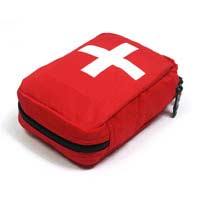Gap Year Emergency Kit

Every gapper going to rural or isolated areas should have a gap year emergency kit with them. This survival kit should include a variety of supplies that could come in handy for a variety of emergencies, including first aid items and survival food. These kits might alternately be referred to as earthquake kits or disaster kits, but their basic components remain the same.
Emergency Kit Components
When you’re stocking up on emergency supplies don’t forget to think long-term. Everything stored in an emergency kit should be able to be stored for several months, if not years, before they need to be replaced.Typical items that come in useful in an emergency include an extra blanket or towel, first aid supplies like bandages and tape, tweezers and scissors, torch and batteries, battery-operated radio and water. Storing copies of documents such as passport or drivers licence may also be helpful in the event that the originals are lost. During real emergencies you will be thankfully to have all of these supplies centralised in one easy kit.<.p>
Survival Food
A survival kit also needs to include survival food, or food that can be stored for a long time without spoiling. Survival food should include a high level of vitamins and minerals, and have enough calories to provide fuel for your body in the event that you must wait a long time before your next meal.In an emergency this food may need to act as your only meal for a whole day or more, so things like meal replacement bars, vacuum-packed, dried or freeze-dried fruits and nuts and other grain or legume based items will come in handy.
Emergency Kit Storage
Stocking up on emergency supplies is only half the battle of making a great emergency kit, the other half is storing them all in an appropriate container and storing the container in an appropriate place. Since you will be travelling, your emergency kit should be small enough to fit in your backpack or other luggage and portable enough to keep with you as you venture out to unknown areas.Lightweight plastic containers are always a smart move, though simply making sure that all of your emergency supplies are in your backpack could suffice as well. If you will be staying in the same place for a while then storing your supplies in a hostel locker or dorm room might also be an option. However, if you are going to leave your emergency supplies somewhere it’s always a good idea to keep a pared-down kit with you, even if it simply contains a bottle of water, snack bar and some plasters.
Emergency kits, also known as earthquake kits or disaster kits, are an important part of staying safe on your travels. Only by taking responsibility for yourself and carrying emergency supplies and survival food with you can you truly be sure that you will be prepared should a disaster strike. If you are going to be staying in one area for a while, then keeping an abbreviated emergency kit with you at all times is still a good idea. After all, you never know when an accident or emergency may strike.
- Replacing a Lost or Stolen Passport
- Being Jailed Abroad
- Staying Safe in the Sun
- Reporting a Crime Overseas
- What to do When Socialising Alone
- Coping With Overseas Emergencies
- Dealing with Natural Disasters
- Safety For Female Travellers
- Avoid Being a Victim of Mugging or Theft
- Drugs and Travelling
- Hitch-Hiking and the Dangers
- Keeping in Touch on Your Travels


Re: Sports Placements
Good Afternoon. My name is Muhammad Hasnain Khan. I am a 2nd year student at Leeds Beckett University studying Sports Coaching. I have checked…
Re: Hitch-Hiking and the Dangers
I think most personalize the experience and say hitchhiking is fine I’ve done it 20+ years with no issues, however it only takes…
Re: Hitch-Hiking and the Dangers
I think most personalize the experience and say hitchhiking is fine I’ve done it 20+ years with no issues, however it only takes…
Re: Hitch-Hiking and the Dangers
I think most personalize the experience and say hitchhiking is fine I’ve done it 20+ years with no issues, however it only takes…
Re: Hitch-Hiking and the Dangers
Having thought this over, I’ve realised the reason this post is so annoying is because of the stupid “safe vs. dangerous” binary…
Re: Hitch-Hiking and the Dangers
“hitchhiking puts travellers at the mercy of others” Yes. Unlike bus travel where you obviously know the driver and the other…
Re: Hitch-Hiking and the Dangers
Haha nice I think I feel so lucky right now as in over two years hh around the world I newer was robbed, killed not even subject…
Re: Hitch-Hiking and the Dangers
Agree with Masala. The dangers are being rather exaggerated. I was taught to hitch by a girl. Stay smart but don’t let fear limit…
Re: Hitch-Hiking and the Dangers
Been hitchhiking for almost 20 years, over 30 countries - Europe, Mid-east, South and Southeast Asia, Australia. I've had only one…
Re: Hitch-Hiking and the Dangers
Lady Hitchhiker and speakingasanexpert: If YOU want to take such stupid risks to your health, safety and possibly your lives,…